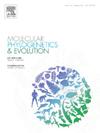Explosion of goby fish diversity at the Eocene-Oligocene transition
IF 3.6
1区 生物学
Q2 BIOCHEMISTRY & MOLECULAR BIOLOGY
引用次数: 0
Abstract
A rapid drop of sea level at the Eocene-Oligocene transition (EOT; 34–33 Ma) triggered a marine mass extinction event and the turnover of terrestrial fauna, but its influence on the diversification of nearshore marine fish communities is unclear. Goby fishes (Acanthomorpha: Percomorpha: Gobiiformes) provide an ideal system to investigate the hypothesis that ecological opportunity at the EOT triggered the proliferation of coastal marine fishes. However, despite more than 30 years of molecular evolutionary research, divergence time estimates for gobies are widely variable, incomplete with respect to sampling of taxonomic families and sub-familial lineages, and far older than evident by the modest fossil record. Here we use 1,314 ultraconserved element (UCE) sequences sampled from 121 species, including all gobiiform families and sub-familial goby lineages, to infer phylogeny and node ages under species tree and relaxed molecular clock models. Our time-calibrated phylogenomic hypothesis reconciles molecular clock- and fossil-based estimates for gobiiform diversification, dating the origin of Apogonidae and Gobioidei to the uppermost Late Cretaceous, with lower to middle Paleogene divergence of the gobioid backbone and an explosion of goby lineages at the EOT. Our results support a remarkably recent evolutionary origin of goby families and stimulate new questions on the seemingly exceptional diversity of the group.

始新世-渐新世过渡时期虾虎鱼多样性的爆发
始新世-渐新世过渡时期的海平面快速下降;34-33 Ma)引发了一次海洋大灭绝事件和陆生动物更替,但其对近岸海洋鱼类群落多样性的影响尚不清楚。虾虎鱼(Acanthomorpha: Percomorpha: Gobiiformes)提供了一个理想的系统来研究EOT生态机会引发沿海海洋鱼类繁殖的假设。然而,尽管进行了30多年的分子进化研究,对虾虎鱼分化时间的估计仍然存在很大的差异,在分类科和亚科谱系的采样方面是不完整的,而且比适度的化石记录所显示的要早得多。本文利用121种虾虎鱼(包括所有虾虎鱼科和亚科)的1314个超保守元件(UCE)序列,在物种树和松弛分子钟模型下推断了虾虎鱼的系统发育和节点年龄。我们的时间校准系统基因组假说与基于分子钟和化石的对虾虎鱼多样化的估计相一致,将Apogonidae和gobiidei的起源定在晚白垩纪的最上层,虾虎鱼骨架的下至古近纪中期分化和虾虎鱼谱系在EOT的爆发。我们的研究结果支持了虾虎鱼家族最近的进化起源,并激发了对该群体看似异常多样性的新问题。
本文章由计算机程序翻译,如有差异,请以英文原文为准。
求助全文
约1分钟内获得全文
求助全文
来源期刊
CiteScore
7.50
自引率
7.30%
发文量
249
审稿时长
7.5 months
期刊介绍:
Molecular Phylogenetics and Evolution is dedicated to bringing Darwin''s dream within grasp - to "have fairly true genealogical trees of each great kingdom of Nature." The journal provides a forum for molecular studies that advance our understanding of phylogeny and evolution, further the development of phylogenetically more accurate taxonomic classifications, and ultimately bring a unified classification for all the ramifying lines of life. Phylogeographic studies will be considered for publication if they offer EXCEPTIONAL theoretical or empirical advances.

 求助内容:
求助内容: 应助结果提醒方式:
应助结果提醒方式:


